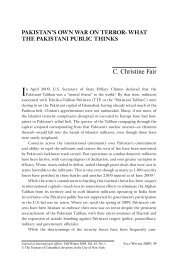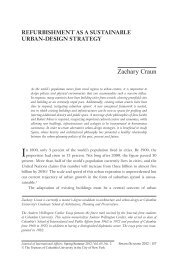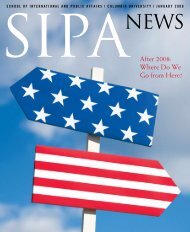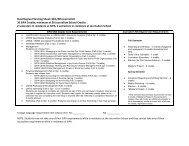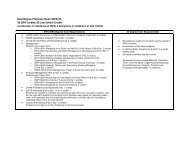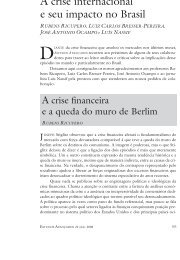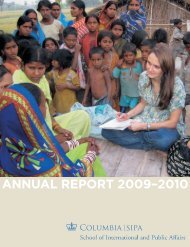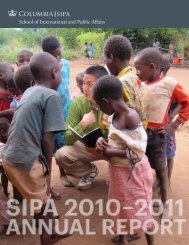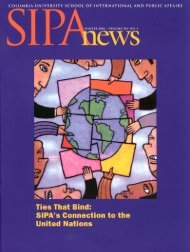SIPANEWS - SIPA - Columbia University
SIPANEWS - SIPA - Columbia University
SIPANEWS - SIPA - Columbia University
Create successful ePaper yourself
Turn your PDF publications into a flip-book with our unique Google optimized e-Paper software.
liberalization has helped to improve competitive<br />
environments, though the region is still far too<br />
dependent on natural resources (more a “curse”<br />
than a “blessing”) for export earnings. While small<br />
and concentrated, the region’s banking sector is<br />
hardly exposed to the toxic assets associated with<br />
the U.S. subprime crisis and has not invested<br />
heavily in risky investments or complex derivatives.<br />
Finally, most governments in the region<br />
have taken steps to reduce the dollar component<br />
of public sector debt, to fund more of the public<br />
debt in local currency, and to issue debt at longer<br />
maturities than had been the case in the past.<br />
One need not argue, and I do not, that the<br />
region has done all of its reform homework or that<br />
its reform gains are solid and irreversible. Reforms<br />
are of relatively recent vintage everywhere, and<br />
backsliding has occurred in countries ranging from<br />
Venezuela to Argentina, often accompanied by<br />
anti-U.S. rhetoric. While Brazil has largely resisted<br />
such pressures and is a star performer in terms of<br />
growth, it has been resting on its oars in terms of<br />
implementing deeper fiscal reforms as well as in<br />
investing in energy, education, and health—the<br />
long-term determinants of economic growth.<br />
What More Can Be Done?<br />
Four policy initiatives need to be considered<br />
in Latin America for the region to reinforce the<br />
levees against the rising waters.<br />
First, fiscal policy plans for 2009 need to be<br />
reexamined with the goal of adapting expenditures<br />
downward (or reducing their planned growth) in<br />
line with a likely deterioration in tax bases. Latin<br />
American budgets, as experience has taught<br />
us, can swiftly switch back into deficits as tax<br />
revenues wither in a crisis and expenditures programmed<br />
during times of prosperity prove politically<br />
impossible to reduce following the onset<br />
of a crisis. Public investment spending probably<br />
should be spared from cuts, but not so most other<br />
categories of government spending.<br />
Second, monetary policy must be vigilant with<br />
respect to the established inflation targets, which<br />
are already under pressure due to rising food prices<br />
and depreciating exchange rates. At a time when<br />
private sector investment is already under pressure<br />
due to faltering global confidence and weakening<br />
currencies, the last thing Latin America needs is<br />
further pressure on domestic interest rates due to<br />
inflation uncertainty. While Latin America seeks to<br />
protect private investment spending to the extent<br />
possible, regulatory and supervisory structures need<br />
to be strengthened to cool off the rapid growth of<br />
Top: Brazilian stock traders negotiate in the future market<br />
at the Future Stock in São Paulo. Right: A worker fi lls the<br />
back of a pickup with bunches of bananas at a market in<br />
Tegucigalpa.<br />
consumer credit, which characterizes many markets<br />
in Latin America.<br />
Third, while Latin America does have the luxury<br />
of large international reserve levels, these are<br />
perishable assets, and they are also costly for the<br />
region to maintain as they require a counterpart<br />
issuance of domestic public debt. The countries<br />
of the region should examine the possibility of lining<br />
up contingent lines of credit with multilateral<br />
lenders, including the IMF and the World Bank,<br />
as a form of insurance policy if the global credit<br />
freeze is prolonged. This will not be a politically<br />
popular move in any country, but the quicker<br />
Latin America acts, the calmer markets are likely<br />
to be when the crisis worsens.<br />
Fourth, in addition to trimming public spending<br />
while protecting public sector investment, it<br />
will be important to ease the impact of slowing<br />
growth and employment on the most vulnerable<br />
populations in Latin America, especially<br />
the unemployed, the less well educated, and<br />
the so-called “working poor.” Latin American<br />
countries have made a great deal of progress over<br />
the last decade in devising conditional income<br />
transfer programs (e.g., Bolsa Familia in Brazil,<br />
Oportunidades in Mexico) to direct spending at<br />
these at-risk groups. Efforts to maintain this flow<br />
of spending, and to improve its targeting, are<br />
critical in tough times to prevent these vulnerable<br />
groups from swelling the ranks of the extremely<br />
poor in Latin America.<br />
No aspects of this four-point emergency<br />
agenda will be easy. Fiscal cuts needed to<br />
protect investment and the poor will provoke<br />
fierce political resistance. Temptations will<br />
abound to swell public sector indebtedness, to<br />
preserve middle- and upper-class entitlements,<br />
to impose price controls, to ease interest rates<br />
artificially, and to prevent the exchange rate from<br />
depreciating. These temptations will exist, but<br />
if indulged by policymakers, they can erode the<br />
institutional basis so painfully put in place over<br />
the last fifteen years and which is the best hope<br />
for a recovery of economic growth when the global<br />
credit crunch finally relents.<br />
Thomas J. Trebat is executive director of the<br />
Institute of Latin American Studies at <strong>Columbia</strong><br />
<strong>University</strong>.<br />
<strong>SIPA</strong> NEWS 5






